Oysters with a plastic flavor in your plates for your celebrations!by Léa Bascoul, Vincent Dumontet and Sophia Lestringuez
Published by the November 8, 2021 on 5:52 PM
For over half a century, global plastic production has increased exponentially. Plastics represent 50% to 80% of marine litter. Microplastics (MP) are derived from the degradation of larger plastic articles or directly produced as microparticles (< 5 mm). Oceans have a “funnel” effect concerning MP drained from rivers and streams, they concentrate pollution from fresh waters in the oceans. In pearl farming structures and equipment, the use of plastics is a source of pollution to the detriment of the lagoon ecosystem. Due to their ubiquitous and small dimensions, MP are likely to be ingested by many organisms and in particular by the oyster, Pinctada margaritifera (Figure 1), which is a species of ecological and commercial interest. So, the objective of the study is to assess the impact of these microplastics on the physiology of this oyster species from the pearl lagoon of Ahe atoll, in the waters of French Polynesia (Figure 2).
Figure 1: Pinctada margaritifera
Figure 2: Ahe atoll localisationIn order to assess the effects of these molecules, IFREMER from French Polynesia, recreated microcosms [1] where oysters are exposed to polystyrene microbeads. Indeed, polystyrene is one of the most widely used plastic polymers and the most found in marine ecosystems.
After two weeks of depuration, oysters, were divided into three treatments. For each, 24 oysters were exposed to polystyrene solutions for two months. These solutions were a mixture of polystyrene microbeads of different diameters (6 and 10 μm) at equal weight. A control was carried out without exposure to polystyrene. Each tank, kept homogeneous, was exposed for 12 hours a day to light and the physico-chemical parameters were kept constant. The microplastic solution was injected continuously into the tanks associated with a mixed diet of two microalgae (Tisochrysis lutea and Chaetoceros gracilis).
Figure 3: Experimental exposure device of oysters to microplasticsDuring the experiment (Figure 3), various parameters, like oxygen consumption, were measured to assess the different energy expenditure of the oyster. Expenses related to food (ingestion rate and assimilation efficiency), to growth (the scope for growth defined from the energy budget and the shell growth rate) as well as those allocated to reproduction (characterization gonad [2] size and analysis of gametogenesis [3]) are quantified in each experimental group and compared to the control. The measurements were carried out on eight oysters per treatment after one month and then at the end of the experiment.
This experiment made it possible to demonstrate that at low MP concentrations, pearl oysters suffer adverse consequences for the sustainability of their populations. In fact, the metabolic responses of a stressed organism can lead to an increase in an individual's energy costs, forcing the organism to sacrifice some of its energy normally allocated to functions, such as growth or reproduction.
In this classical and standardized experiment, the oysters exhibited a significant dose-dependent reduction in the “scope for growth” without however modifying the shell deposit rate. On the other hand, although the ingestion rates of the microalgae were not affected by the microplastics, for an equal volume of filtered water the assimilation of the microalgae is disturbed by the presence of the microplastics and the energy supplied by food is lower. This is either linked to interference in assimilation processes in the digestive tract or to indirect competition between algae and microplastics.
The fact that metabolic (respiration) rates are not impacted suggests that the only possibility for the oyster to cope with a decrease in available energy is to modify its gametogenesis and / or its reproductive effort. However, reproduction in P. margaritifera is continuous and requires a lot of energy. The results of the study show that reproductive effort is not affected but that gametogenesis is strongly impacted. Thus “small holes” in the gonadal tubules [4] are observed in oysters exposed to microplastics. They could therefore be the start of the phagocytosis [5] of germ cells initiated to recover energy (Figure 4).
Figure 4: Impact on P. margaritifera metabolismIn a few words, the pearl oyster exposed to MP for a period of two months maintains its metabolism and its vital functions to the detriment of its reproduction, and therefore the sustainability of its future population.
This study could also serve as a model for the MSFD [6] Technical Group Marine Litter to assess the effects of microplastic litter in biota (D10C3), because the effects observed on Pinctada margaritifera in the lagoon of French Polynesia must be the same as on other filter feeding bivalves in Europe. The European Technical Group Marine Litter could thus propose a regulation of waste at the European level and not only at the level of the lagoon of French Polynesia.
The experiment results should support decision-making on plastic waste management measures in Polynesian lagoons, especially in atolls that have decades of pearl culture history without waste regulation or clean-up. This work would provide the necessary information to local authorities to regulate pearl equipment and establish a waste management policy such as the collection and recycling of this equipment.
The aim of the study was to measure the impact of microplastics on the metabolism of Pinctada margaritifera. The team of researchers therefore sought to artificially recreate different levels of pollution in the laboratory. This methodology is suitable because it aims to recreate the pollution conditions possibly encountered in natural environments. To measure these different levels of pollution, the experiment is carried out at different concentrations. As for the various parameters measured to assess energy losses, they make it possible to identify, in a non-invasive manner, the functions (growth and reproduction) "sacrificed" to cope with the loss of energy. They also allow us to see if this loss of energy had an effect on the metabolism of oysters. The parameters monitored therefore seem consistent for this study and could be used for similar studies on other bivalve filter-feeding organisms. Experiments using this protocol could be considered in fresh waters with other types of bivalves such as the mussel pearl (Margaritifera margaritifera). Also, this study can be evaluated with a direct approach on oysters from pearl farms and over several generations.
In several years, oyster populations on a global scale could be impacted by pollution from microplastics … so, if there are no more oysters, what will we eat with our white wine?
[1] smaller version of ecosystem
[2] an animal organ in which gametes (a haploid germ cell, such as a spermatozoon or ovum) are produced
[3] gamete formation process
[4] organs of gametes excretion
[5] cellular defense process, destructive function of phagocytes
[6] Marine Strategy Framework Directive

This post is licensed under a Creative Commons Attribution-ShareAlike 4.0 International License.Help! How do I manage my commercial oyster nursery?by Coline Arqué, Marylou Pourret and Robin Thibault
Published by the September 6, 2021 on 4:16 PM
Evaluation of food limitations in commercial oyster nurseries: an aid for managers
Oyster production provides an important number of ecosystem services (nutrient cycling, providing habitat for other marine species, ...). Furthermore, shellfish farming is promoted and recognized as providing social and economic benefits, as well as ecological benefits. Oyster growth and production depends on several factors such as temperature, salinity, freshwater flow/rainfall, current speed, density, feed concentration and phytoplankton species composition, feed sharing with other species and disease outbreaks. For this reason, modeling can be useful in understanding the feedback between agricultural and environmental systems and the effects on production. Mass balance models can help estimate the food requirements of a given spat stock.
Objectives:
- Develop and evaluate model for different culture structures using Pacific oyster spat
- Make the model available online for wider use
- Ensure it tackles two questions that arise when planning or managing an oyster nursery: how much food is required to sustain a given stock and for a typical range of food available in the surrounding environment, what is the maximum biomass that can be stocked
Why use the Pacific oyster?
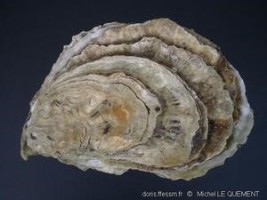
Crassostrea gigas (Thunberg, 1793)- Strong Economic Interest: 4.4 million tons in 2003 (FAO)
- The cultivation is well suited: to small family businesses, cooperatives or regional industry
- The grow-out phase can be carried out by: relatively unskilled labor with minor investment in equipment and infrastructure
The overall goal of this model is to estimate the food inputs for a given stock biomass; and the maximum stock biomass for a given external food concentration.
Different parameters were considered in this model relied on the experiences of Langton and McKay (1976) ...
Level of food supply
Simulations of two feeding levels with an interval of 6 hours:
- Exp A : Exp A: daily intake of 180 algae cells/μL x 250 L of tank
- Exp B: 120 algae cells/μL x 250 L of tank
In addition, to mimic the experimental setting, the model application includes only one class of oysters, so that at each run of the model, the spat size is set to the same size obtained from the weekly observations of Langton and McKay (1976) for the 6:00/6:00 regime.
[Food]Nursery
Key parameter used in the model as the optimal concentration to be maintained in the production unit. [Food]nursery: minimum dietary concentration that maximizes intake OR optimal concentration for growth.
Temperature
Chosen according to other references on the subject. The temperature for the maximum clearance rate is approximately 19°C. Thus, the lower limit of the model is set at 4°C and the upper limit at 30°C.
The biomass of the stock was calculated by considering the density of 50 spat per liter, multiplied by the volume of the tank (250 L) and by the size of the seeds.
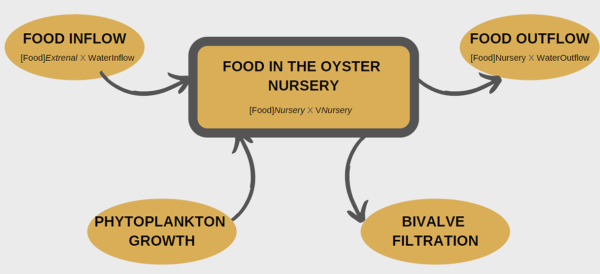
Conceptual model for the oyster nursery.The choice of a model that takes several parameters into account allows a rendering close to reality. This application is a useful tool for managers who can limit as much as possible the costs that are not essential for the good development of a species. Indeed, the aquaculture environment is a field with high socioeconomic stakes. Therefore, it is useful in the long term to find new management concepts for sustainable resource management.
RESULTS
Week 0
Week 2
Week 3
Following weeks
Exp A
Exp B
Exp A
Exp B
Exp A
Exp B
Feed supplied is much higher than the stock requirements
Feed level supplied is still enough
Oysters are fed less than the optimum
Feed level supplied is near the threshold
Feed level supplied does not meet the needs of oysters
lower spat weight for experiment B than for experiment A
These different growth rates measured in Exp A and B (Langton & McKay 1976) confirm the model's predictions of dietary limitation. The results of the model are also consistent with those of Langton and McKay (1976), which predicted that oyster spat are not diet-restricted during the first two weeks. The model outputs provide the feed requirements to ensure minimum concentration in the nursery. It also gives the maximum biomass that can be stored to ensure a minimum concentration in the nursery for optimized growth.
ASSISTANCE TO MANAGERS
In order to promote widespread use, the model described in this paper for Pacific oyster nurseries is made available online: http://seaplusplus4.com/oysterspatbud.html. It allows to carry out simulations on several types of nursery systems.
This work describes the model user interface, including the menus for nursery setup (and seed characteristics), output for food requirements, output for optimum stock, and advanced settings (allows the user to modify the optimal feed concentration for oyster filtration). Examples on how to use the model for different case studies are also provided.
Model limitations include the following:
- Important effects that occur at smaller scale are not simulated in the model, e.g., changes in the water flow rate due to oyster size/densities or tank shape
- The option with bloom tanks assumes these are interconnected with the oyster-holding tank, which together are the simulated unit. In this case, the water flow is the water that enters from the outside (an adjacent ecosystem for instance) into the bloom tanks forced by tidal height or pumped
- The salinity effects on filtration rate are not simulated and thus it is assumed that water salinity is higher than 20
MODEL APPLICATION TO FARMS
In spite of the model simplification, it can still provide guidance for managing stock and food limitation in natural feeding oyster nurseries. It offers a wide range of possible scenarios in which the nursery operates. It provides guidance for the management of stocks and food limitation in naturally fed oyster nurseries. In addition, it also allows a quantification of the general rules concerning the spat holding capacity for a given nursery. Finally, the total biomass stock that can be maintained will depend on the quality of the spat.
The cost of producing a species like oyster for commercial purposes needs to be limited. The technique applied in this paper to get there is sound for oyster farmers. It is important to know all the biological and ecological aspects related to the good development of this species. The food aspect is a primordial resource in the growth of a species. Therefore, the model proposed in this study is useful to better understand what the essential nutrient inputs for the good development of the oyster are. However, there are many factors influencing the growth of these organisms and further study to refine the model may be required.
TO CONCLUDE …
The model:
- Presented provides an assessment of the seed stock limitations in an extensive commercial oyster nursery that can function with respect to food limitation.
- Provide valid indications on the limits of the maximum stock in a given nursery or on the food requirements of a given spat stock for optimal rearing conditions.
- Is intended for managers of commercial operations and can be used online.
- Can be developed based on feedback from the growers regarding its usefulness.
In addition, other features they consider important could be included, as well as other oyster species. We can also apply it on other biological models with a strong economic interest and whose physiology of the species is suitable for study in a controlled environment.
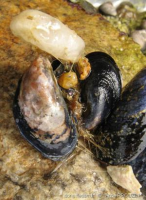
Mytilus edulis (Linnaeus, 1758)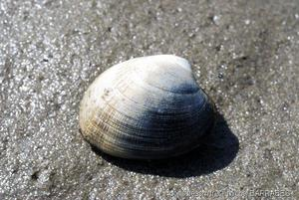
Ruditapes philippinarum (Adams et Reeve, 1850)This model is applicable to species whose production cycle can be controlled. Indeed, the model studied is a tool that tells us the maximum amount of food necessary for the proper development of the species. Therefore, it cannot be adapted to species that cannot be analyzed in a closed and controlled space. It should be noted that linking statistics to biology is a fundamental approach to evaluate and understand a species in the best possible way while including other parameters that may have a negative or positive effect on it. Furthermore, it would be interesting to extend this study to other oyster species and other organisms concerned by these culture systems. In addition, as the authors say, it would be interesting to consider the opinion, yields of shellfish farmers in order to improve the model for a better management aid.

This post is licensed under a Creative Commons Attribution-ShareAlike 4.0 International License.Are pesticides more dangerous when you are hungry?by Angèle Lorient
Published by the January 6, 2020 on 1:52 PM
Today, the impact of pesticides on our environment is a central issue in many publications and a major concern for all citizens. Between 2014 and 2016 the use of pesticides increased by 12%. Indeed, intensive farming currently used implies that we find in our food, in the air but also in water, traces of pesticides. A 2013 Inserm report highlights a link between exposure to pesticides and the appearance of cancer or pathology such as Parkinson's disease but also developmental problems on children. Therefore, they harm the health of humans but also the entire terrestrial and aquatic ecosystems.

Water Flea Daphnia Magna. www.aquaportail.comIn addition to using a large amount of chemicals, modern farming methods make soils less permeable. As a result, precipitation runoff is a major contributor to pesticide pollution from our streams. In order to study the toxicity of pesticides in the aquatic environment, the majority of laboratories use Daphnia as an indicator of water quality, and in particular the species Daphnia magna for their sensitivity to toxins.
Daphnies are small crustaceans measuring about 1 to 4 millimeters. They live mainly in fresh water (river, pond, lakes). They are filter feeders that help maintain the clarity of the water thanks to their ability to eat green algae. During a day they move between the bottom and the surface of the water depending on the light (photoperiod).
In 2006 a study was conducted by 4 scientists (2) to study the physiological responses (sensitivity, growth, reproduction) of daphnies to different dietary concentrations of the same pesticide to which they and their mothers were subjected. (high food or low food).
The study shows that lack of food does not play a direct role in the sensitivity of daphnies to the pesticide in question. However, it is one of the factors determining the level of absorption and elimination of this toxic substance by the body. In addition, the energy used to fight this toxin has a negative effect on the maintenance of vital functions.
In a period of low availability of food resources, invertebrates will have a more limited growth and a lower reproductive rate in proportion to the level of pesticide present in their environment. While the impact is less when they are subject to sufficient food resources (Fig 1).
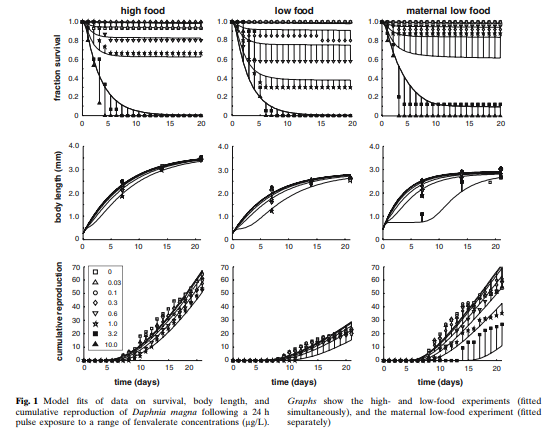
For the different types of food resource, the effect of the pesticide concentration is proportional to the survival rate. On the other hand, we can notice that there is a threshold effect concerning growth and reproduction.
However, they also highlighted that these individuals, when no longer subject to the pesticide, found a normal activity (resilience).
This study makes it possible to highlight the potential impacts on the results of the experiments if certain non-standardized conditions vary between laboratories (concentration of food, respect of the photoperiod). As well as the differences in test organism responses between conventional environmental conditions (controlled artificial environment) and the natural environment (subject to variations).
The analysis of the results of this study raises the following questions:
- What is happening in the longer term?
- Does the repeated presence of pesticide pulses have the same physiological effects on an individual throughout his life?
- Is the speed of resilience due to the species or can it vary individually?
- Is there resiliency of newborns from underfed mothers?
It also shows the urgency of taking into account the impacts of pesticides, both on our current health, on the heritage that we will transmit, but also on our ability to reproduce. Despite the mobilization of the Ministry of Agriculture including the program "Ambition bio 2017" there is urgency. Pesticides are one of the main causes of pollution in our waterways. This pollution endangers aquatic life, as has been demonstrated, but also the drinking water resource. Should not our entire consumption system be called into question in order to be able to realistically implement the planned management plans?

This post is licensed under a Creative Commons Attribution-ShareAlike 4.0 International License.Avoid predation or starvation: which strategy maximize rainbow trout juvenile survival?by Léa Bulon and Mylène Jury
Published by the September 9, 2019 on 7:12 AM
Natural populations are increasingly exposed to a range of biotic stressors, such as predators, and abiotic environmental stressors such as environmental variations (seasonality - Wingfield, 2013) or chemical pollution (Fisher et al., 2013). (We could think to grandma Margaret who throws away her bleach bucket directly into the river or grandpa George who loses all his plastic lures into the lack). The first year of life is complicated for all organisms because they are more sensitive to those kinds of stressors and their survival is highly impacted.
In temperate zones, fry are subjected to high predation during the growing season and a nutritive resource deficit during winter. This is why juveniles need to find the best way to maximize their survival and make population viability durable through the time. Predators prefers a fry-up of little fish, it is why predation mortality is higher in small fish than large (Parkinson et al., 2004). However, growth itself may impose a significant energy mobilization which can drive trade-offs between growth and other metabolic processes. If you are really interested by the topic but not by fish, we recommend you to look at the article written by Mcleod et al., 2008, about birds.
During winter, the metabolism needs some fuels like lipids and proteins to work because resources are often limited. Production of energy storage is energetically expensive, and energy contributes less to increasing their body-size.
Is it better to allocate their energy into the growing season to avoid predators or into the lipid storage to survive during winter?
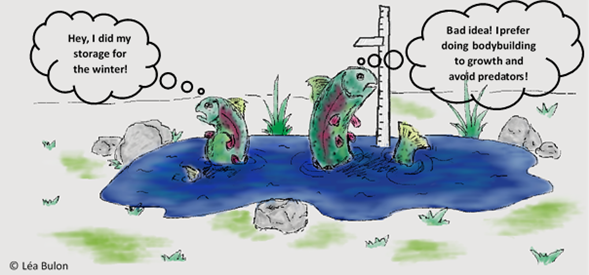
To store or to grow? That is the questionStephanie Morgensen and John R. Post, scientists from Canada, are been interested in this process. They led an experiment with juvenile rainbow trout (Oncorhynchus mykiss). They developed a mathematical model to determine the energy allocation strategy maximizing the first-year survival of rainbow trout.
Rainbow trout juveniles are sampled from two sets of lakes in British Columbia in Canada. The first site is located on the Bonaparte Plateau and it corresponds to highly and cold lakes. The second site is located near the town of Merritt and it corresponds to low altitude and warm lakes. In warm lakes, the winter season is shorter than in cold lakes and there are more resources for juveniles.
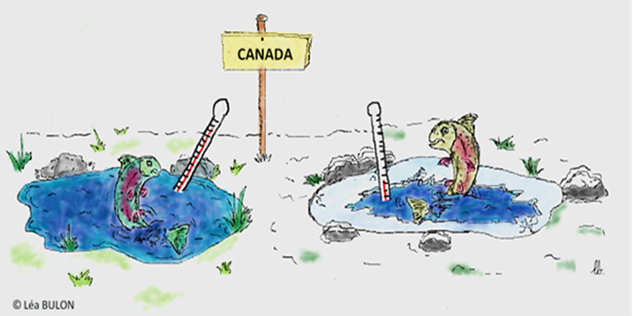

Canada: birthplace of the rainbow troutThey found that juvenile growth is different between the two kinds of lakes: fish from the cold lakes growth more than fish from warm lakes. As we said before, production of lipid storage consumes more energy than growth and resources are more abundant in warm lakes. It is why, fish from warm lakes are more able to stock and fish from cold lakes, to growth. However, fish do not follow only one strategy. Indeed, they grow during the first part of the non-winter season and then they put their energy into the lipid storage to survive during winter. This switch between the strategies is controlled by environmental conditions and determined trout survival during winter.

How many fish survive during winter?The juvenile survival trade-off influencing by environmental conditions such as temperature and resource availability would be important to understand population viability with the evolution of environmental conditions. Rainbow trout has been introduced into many streams and water bodies for recreational fishing because they are easy to catch and quite combative (fishing federation). They constitute an important economic interest it is why, it is one of the most studied species by biologists (INRA). This may lead to management measures to improve pisciculture conditions or to instore fishing quotas and a minimum size of capture. It could be also interesting to know if energy allocation strategies affect physiological processes like growth or reproduction.
And you what would you choose to survive during winter?

This post is licensed under a Creative Commons Attribution-ShareAlike 4.0 International License.Zinc pollution of our rivers: shrimp on alertby Lucille Baron and Macha Joanin
Published by the August 12, 2019 on 10:03 AM
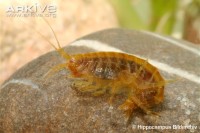
An individual of Gammarus pulexNo, we will not make an exhaustive catalog of the pollutants that affect our streams and boredom will not settle in your heads by reading us. Instead, we have chosen to discuss the effect of one of the very present emerging pollutants zinc on Gammarus pulex, through the study of Maltby and Naylor (1990).At present, world zinc production is over 13,000 kilotons (2018). Zinc is commonly used in metal corrosion coatings and for the manufacture of fertilizers and pesticides (European Commission, 2008b). Thanks to its physico-chemical properties, zinc melts particularly in fresh water, and it is absorbed on suspended solids and sediments (INERIS, 2014). All organisms living in these ecosystems are therefore exposed to this pollution and therefore, indirectly, we too, human.
Thus, it is important to measure the risks of this exposure on organisms and especially to know the effects of zinc on populations in the long term. For this, researchers have studied, experimentally, the energy deployed in the reproductive mechanisms by aquatic organisms exposed to zinc at different concentrations. In additions, they sought to know if exposing females during a first brood (called current) could have an effect on their second brood unexposed (called subsequent).
Gammarus pulex is a sentinel species, not only because this shrimp is abundant in fresh waters of England, but in addition it is fed with particulate matter which constitutes, in the natural environment, a large zinc stock. To measure the risks of maintaining the species and the genetic heritage of each individual under the effect of zinc, it is sufficient to study the offspring of females exposed to this compound at different concentrations. The number of individuals which hatched, and the size of each one give some indication of the energy allocated to reproduction. That's what researchers at the British Ecological Society did. If you haven’t understood anything about our attempt to explain the methods used to carry out the study experience, here is a summary diagram that you may be clearer!
Diagram of the methods used for the experimentThe results they obtained are surprising and show that exposure to zinc (even at low concentrations) significantly increases the number of broods aborted. This result is related to the decline of foods assimilated by females when they are exposed to zinc. The total energy drawn from food is no longer sufficient to sustain metabolic needs while maintaining the mechanisms of maturation and reproduction. Nevertheless, when exposed females carry her brood to term, the number of offspring of each does not seem to vary, despite of the difference in duration of exposure. So, a small criticism of the Figure which represent the percentage of broods aborted in function of the concentration of zinc (Figure 3) can be realize : we found in the control situation (not exposed to zinc), a great variability between the two categories tested. So, in science when the" control "already has significant variability, the results should be interpreted with caution thus it is difficult to conclude to a difference between the current and the subsequent.
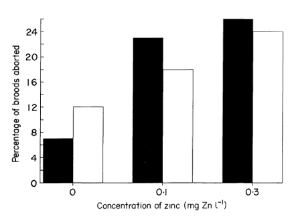
Effect of zinc on the percentage of broods aborted. Solid columns (black) represent “current” broods and open columns “subsequent” broodsThe results concerning the size variation of the descendants, bring a complementarity to this analysis because the researchers observe a reduction of the size in the generations following the exposure. It is the reduction of the available energy (females stopping feedings) which as a consequence the reduction of the size of the individuals of the next brood. Also, on this point, it is unfortunate that the study does not take into account the size of the female that could have an impact on the size of the offspring (Taïr-Abbaci K., 2016).
The increase of the number of broods aborted and the decrease of the size can have a negative impact on the fitness of populations as exposure to zinc increases abortion. Also, the smallest offspring will take longer time to mature and under stress conditions, this phenomenon may be aggravated over generations and the snowball effect may strongly decreased fitness of individuals. Ultimately, these effects can have a profound impact on the entire population.
The study seems relatively far from reality since it remains experimental, in the laboratory, and is not carried out in a natural environment and therefore with real conditions of experimentation and exposure to zinc. Thus, the adaptations set up or not by the organisms and the cocktail effects (potential combined effect of different compounds) are not taken into account.
Nevertheless, the study above begins to be old, the latter dating back to 1990.Today, techniques allow to observe the embryonic development precisely and it turns out that during the different embryonic stages aberrations can appear (Bach et al., 2010). Then, it is difficult to think that abortion is the only response implemented by females when exposed to these chemical compounds.
In addition, reproductive success does not depend solely on embryonic development. It is important to consider the energy allocated to ovocyte development and the search for sexual partners to define the impact of zinc on the Gammarus pulex cohorts.
It’s possible to reduce the production of zinc with recycling it. However, the recycling of metals can sometimes be too expensive for small industries or privates companies. So, there are other ways than the installation of water decontamination mechanisms. Thus, bio-decontamination can be considered for these companies or industry but can also be useful to large industry in addition to their mechanisms for an exhaustive decontaminations and better water quality. Agriculture is also a source of metal pollution, so it is important to carry out hedgerows planting campaigns near fresh water since they have the function of absorbing a large part of the contaminants resulting from the leaching of flooded soils.

This post is licensed under a Creative Commons Attribution-ShareAlike 4.0 International License.
Identifying the optimal depth for mussel suspended culture in shallow and turbid environments.by Yann Godard and Louna Riem
Published by the February 1, 2019 on 4:52 PM
Bivalve aquaculture is commonly carried out in shallow water where there is an important influence of winds, tide and currents. These factors can lead to the remobilization of particulate matter which is an important source of food for bivalves. However, the concentration of the particulate matter in water can be minimized by the filtration capacity of high density cultured bivalves. In order to improve the productivity of cultured bivalves, it is important to take into account these different parameters. Indeed, it will help to know where is the best place for bivalve’s growth.
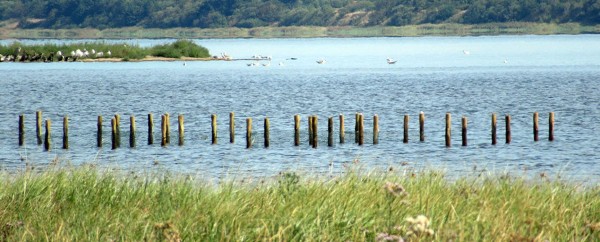
Skive Fjord mussel farms - https://northsearegion.eu/watercog/pilot-projects/skive-fjord-dk/A study conducted in a Fjord in Denmark suggests that the TPM (Total Paticulate Matter) in the environment of culture is very important for the growth of mussel. The autors have built two models to understand the mechanism:
- The first model try to give a pattern of the vertical distribution of resuspended materiel by including, among others, the particles concentration at 1m above the seafloor
- The second model allows seeing the growth mussel at different height in the water column and calculates growth rates. This is made under different scenario of food availability.
Both of these models allow determining the optimal localization of mussel in the water column for the better production.
Firstly, the authors have determined the characterization of seston in the long-term and in the short-term. They observe that there was important correlation between wind and TPM but with a lag of 9 hours. Thus, they say that the remobilization of particles is not depending of the wind in the farm but of the remobilization in another place in the fjord for the short-term seston characterization. These particles are then transported by water current until the Fjord. Moreover, a correlation is also observed between the chlorophyll concentration and the TPM but not between the water velocity and TPM.
For the long-term, they were able to highlight that the repartition of seston, and particulary phytoplankton in the water column was not homogeneous. There is a difference in concentration at the bottom and at the top with more phytoplankton at the surface (because of the lightening).
Secondly, the authors wanted to characterize the growth of mussels under different conditions of availability of food with the hypothesis that the concentration of phytoplankton is homogeneous in the water column. The results say that in reality, there is more phytoplankton in the surface, then, the growth in the top is not very well implemented in the model. They conclude that it is important to consider the position of bivalves in the water column for an optimal growth.
The dynamic energetic budget model shows that it is important to have a lot of phytoplankton and less detritus in order to get a better growth whatever the position of the culture. Moreover, this model allows showing that the variation of growth between the top and the bottom is only 2.6% which is negligible. They conclude this part by suggesting that “The reduced impact of height above the seafloor on mussel growth is related to the small contribution of resuspended material compared to the high background concentration of detrital matter”.
This study takes place in a Fjord where the conditions are highly variable (changes in the tide, current, wind…). This is not implemented in the model. Therefore, it could be interesting to add some hydrodynamics parameters in the model in order to adjust it. Moreover, to improve the model, it would be wise to include some biological mussel parameter like the energetic costs of pre-ingestive sorting and pseudofaeces production. This model could be experimented in different places and different moment to validate it.

This post is licensed under a Creative Commons Attribution-ShareAlike 4.0 International License.Use of dynamic energy budget and individual based models to simulate the dynamics of cultivated oyster populationsby Maxime Rochet and Jean-Baptiste Valerdi
Published by the October 8, 2018 on 12:45 PM
This paper deals with a test of Dynamic Energy Budget (DEB) apply for predictions of the oyster Crassostrea gigas production in Thau Lagoon. The DEB model is based on physiological and environmental parameters, he predict the growth at indivual level. In the case of oyster production the prediction must be applicate at the cohort levels, its why they choose to integrate the DEB model into a population dynamics concept. Population model choose its the IBM (Indivifual Based Model) method, the equations are used for the predict the harvested production and the stocks in place (total number of individuals). The advantage of this integration its to assess the effect of ecosystem changes on oyster production.

Oyster farming in the Thau Lagoon - Olivier Pessin - CC BY-SA 3.0The models recently used (DEB) have been compared with a more common prediction tool. The partial differential equation (PDE) are empirical equations used for the growth prediction between different class and simulate by individual total mass. This equation are more straightforward than the DEB-IBM models but they use only a single variable to represent individual growth. The DEB model integrate two variable of calibration, the other parameters of the differents equations were estimated from independent datasets using comprehensive studies of oyster growth and ecophysiology under controled conditions. The calibrated parameters are the chlorophyll a concentration proxy of the phytoplacton biomass (principal food of oysters) and the température linked to assimilation and maintenance rates. This technique modelise by this way the indivdual capatcity of food assimilation and the allocation of energy between energical reserve, structural tissues ans reproductive structure and maintenance. To be more likelihood a growth variability showing variability between individuals have been implanted. Some variability have been implanted into the prediction of PDE method and the DEB-IBM model. This variability was integrate by diffusion to reproduce the variability between individual growth in the PDE and by Xk (half saturation coefficient) variability in the DEB-IBM case.
The results of the differents simulations have proved a good capacity for the DEB-IBM model to predict the stocks and the harvest productions. The data estimated are close to the observed. He have to advantages to be generic, easy to etablish by the low number of measurables parameters. With the results showed in the study (see figure below) his capacity to take account of the environmment variables have been proved too . The limits are detectable in his sensivity to the variability and the large number of parameters estimated can induce in error.
From Bacher & Gangnery 2006.The comparison of the two models have show the effect of the variability in the predictions values. The values predicted by the DEB-IBM model look closer to the observation than the PDE predictions. For exemple the harvestes productions have been estimated earlier by the PDE method than the DEB-IBM, so the modelisation of DEB parameters can influe strongly the dynamic population and the production previsions.

This post is licensed under a Creative Commons Attribution-ShareAlike 4.0 International License.Temperature-dependent body size effects determine population responses to climate warmingby Alison Arraud and Laura Duran
Published by the July 5, 2018 on 1:55 PM
Up to now, neither the size nor the stage of the individual were considered to studying the population responses to climate warming. On 2014, a scientific group proposed another way to understand the temperature effects on fish populations. They improved the interaction effects of temperature-dependence with the size and the stage of fish on their energetic thresholds responses. Energetic thresholds themselves act on the dynamic of stade-structured population (e.g. parr, smolt, adult).
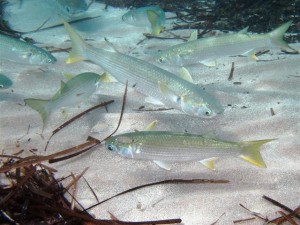
Flathead mullet (Mugil cephalus) - Roberto Pillon - CC BY 3.0 UnportedFinally, this study found that increasing temperature could redistribute biomass across life stages and modify the regulation of the population by reworking the intra-specific competition. Other studies have shown that high temperature during ontogenesis can accelerate the development and growth of individuals or, give individuals of smaller sizes early maturation.
This study points out the importance of taking into account the interactions between temperature and size-specific (maturing, reproduction, etc.) that will lead to a set of behavioral responses that have consequences on the structuring of a population. This is all the more important in the context of global warming.

This post is licensed under a Creative Commons Attribution-ShareAlike 4.0 International License.





